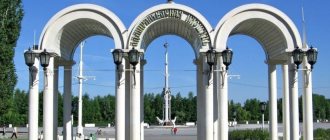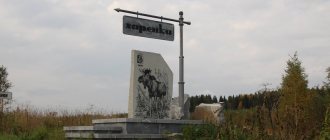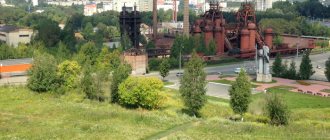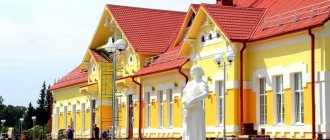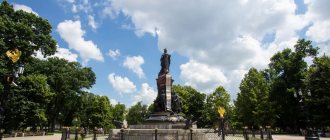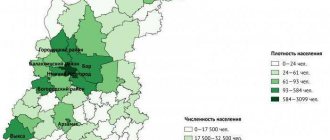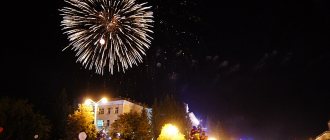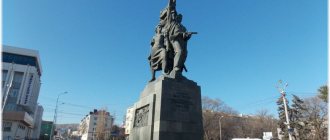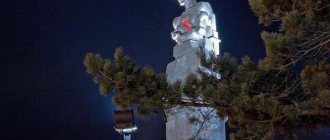Monuments
| Monument to E.A. and M.E. Cherepanov | Model of the first Russian steam locomotive | Light and music fountain | Watchtower on Fox Mountain |
| Monument to the T-34 tank | Monument to metallurgists | Memorial complex Walk of Fame | Monument to tank builders, creators of the T-72 tank |
| Monument to miner Nikolai Nikitich Demidov | Monument to mining equipment | Monument to the First Komsomol Members of Tagil | Monument to the T-34 tank on Prezavodskaya Square |
| Monument to V.I. Lenin (Lenin on the ball) | Sculpture “Artamonov’s Bicycle” | Monument to Tagil residents who died in local wars on the planet | Memorial to fallen railway soldiers |
| Muse. Garden sculpture | Monument to the Heroes of the Civil War | Monument to the miners of the Mine named after. III International, who died during the Great Patriotic War | Monument to the Red Guards of 1918 in the village of Gorbunovo |
| Monument to Ordzhonikidze | Monument to Peter and Fevronia of Murom | Monument to the Border Guard | Monument to worker correspondent G.S. Bykov |
| Monument to VSW workers who died during the Great Patriotic War | Monument to police officers who died on duty | Monument to Tagil residents-Heroes of the Soviet Union | Monument to F.E. Dzerzhinsky |
| Memorial sign at the site of the plane crash on May 9, 1993 | Sculpture “City Angel. Skepticism" | Sculpture Readers |
Monuments of Nizhny Tagil
Monument to the Cherepanovs in Nizhny Tagil
, located on the Drama Theater Square, is the most suitable object for starting to get acquainted with the works of monumental art of the city. The monument to these serf engineers, the pioneers of steam traction, symbolizes the continuity of generations, loyalty to their native land, qualities that are characteristic directly of the residents of Nizhny Tagil, the city of Ural workers.
The so-called technical monuments are widely represented in Nizhny Tagil:
– Numerous monuments to the steam locomotive
. Firstly, this is a monument to the model of the Cherepanovs’ second steam locomotive, located at the entrance to the Museum of Local Lore. Secondly, located between the railway and bus stations, the monument “In the Homeland of the First Steam Locomotive...”, which represents the last steam locomotive of the Nizhny Tagil branch of the railway, which worked on steel lines, ascended to the pedestal under its own power.
– Tank monuments
.
This is a monument to the creators of the T-72 tank on Tank Builders Square, and a monument to the T 34 tank,
the current model of which is installed near the central entrance of UralVagonZavod. Near the building of the upper food warehouse of the Museum of the Environment, on a pedestal with the inscription “In honor of the victory in the Great Patriotic War,” there is another T34 tank, which belonged to the crew of the 19th separate training tank regiment and the 2nd training tank brigade.
The fate of Nizhny Tagil is inextricably linked with the name of the Demidov breeders. In the Komsomol square, opposite the stone flower fountain, there is a chic monument to the representative of the fourth generation of Ural magnates, Nikolai Nikitich Demidov. It should be noted that the location of the monument itself has changed several times in accordance with the trends of fundamental propaganda. At various periods of history, there was a chapel, a monument to Alexander II, “Fallen Freedom Fighters”, and Stalin.
In every district of Nizhny Tagil there are monuments to workers in various manufacturing industries. At the foot of Fox Mountain there is one of the largest monuments of this kind - the monument to the Metallurgists.
Monument to the first Komsomol members, monument to Peter and Fevronia
, the working correspondent Bykov, little Volodya (Ulyanov) - the list can be endless.
In Nizhny Tagil, as well as in any large administrative center, there are several large memorial complexes:
– monument to the Red Guards of 1918,
– Walk of Fame,
- a monument to the police officers who died at a combat post.
The city is replete with small sculptures, such as “Artamonov’s Bicycle”, “Readers”, “City Angel. Skepticism", "Muse".
Sculptures of Nizhny Tagil
The sculptures of Nizhny Tagil soften the appearance of the harsh industrial city. Whatever one may say, he does not shine with beauty. In Nizhny Tagil, metal is melted and tanks and carriages are made.
Table of contents
Sculptures of Nizhny Tagil. Bondina Park
It was all the more gratifying to visit the city park on the shore of the Tagil pond. The park is decorated with many statues of modern characters. Unfortunately, I was unable to find the name of the sculptor. All that remains is to show his creations. The first we came across was the sculptural group “Waiting”. This condition is familiar to most men. When a nearby street lamp was asked, “Are all women late for dates?” he replied, “Not all women are. Some people just don't come."
Nearby is the composition “Family” filled with happiness.
Charming “hide and seek” evokes affection.
A “chess player” sat down on a bench nearby.
The “photographer” - perhaps Sergei Mikhailovich Prokudin-Gorsky himself - aimed the ancient camera...
for some reason on the bridge of lovers.
The “readers” were especially memorable. They seem to be urging you to turn off your smartphone and open a book. After all, it is the book, not the Internet, that is the source of knowledge.
Perhaps the cutest statue after “Hide and Seek” is “Sloppy” - a boy dangling his legs in the fountain.
"Cityman" and "Janitor"
Tagil sculptor Alexander Brusnitsyn sculpted a local policeman in 2015. The character came out massive, with a luxurious mustache. He is dressed in a government overcoat and resembles a character from Chekhov’s “Chameleon”. Although Anton Pavlovich’s hero was not an ordinary security guard, but an entire police officer. There were no policemen in Nizhny Tagil. Until 1918, it had the status of a village. The zemstvo police served here.
There is an iron “janitor” nearby. Not just standing, but “sweeping” the street. The statue was created by Nevyansk sculptor Yuri Zaikin. There is a cat hanging on the broom handle. He is trying to catch a pigeon. The janitor not only sweeps the street, but also scares the cat.
“The Janitor” by Yuri Zaikin. Sculptural composition in Nizhny Tagil.
Works by Alexander Ivanov
Sculptor Alexander Ivanovich Ivanov was born and lives in Nizhny Tagil. Since 2005, he has been creating sculptures from welded metal. His work “City Angel” is based on the novel “Doctor Zhivago”. The character doesn't look like an angel at all. Only his wings allow him to be considered a celestial.
City Angel
“City Angel” can be found on Uralskaya Street, 7, next to the Nizhny Tagil Museum of Fine Arts.
Nearby (Uralskaya, 9) reclines a “beautiful lady”, made in a similar manner. However, Ivanov’s authorship is not indicated. Perhaps this is just an advertisement for a beauty salon.
In 2015, Alexander Ivanov created a caricature of the Statue of Liberty. According to him this is:
manifesto of good provincial sanctions
They show the attitude of the “deep people” towards the West. The sculptor placed a stork's nest on the head of the statue.
"Freedom" in Tagil. Sculptor A. Ivanov.
The Ural Statue of Liberty was installed at Krasnoznamenaya Street, 136 A.
Sculptures of Nizhny Tagil. Monument to the Cherepanovs
In Nizhny Tagil there is a traditional set of Lenin, Dzerzhinsky and tanks. They don't arouse interest. However, one classic monument deserves attention. It is dedicated to the Cherepanovs, the creators of the first Russian steam locomotive. The Cherepanovs were by no means brothers. This is Efim Alekseevich and his son Miron Efimovich.
Efim and Miron Cherepanov. Sculptor Kondratiev
The decision to install the monument was made in 1945. The sculptor Kondratiev was a famous Soviet master and made his living by sculpting and casting the “founders”: Marx and Engels. That is why Efim and Miron Cherepanov are so similar to the popularized classics of “Marxism-Leninism.” By the way, Efim Cherepanov hardly knew how to read and write and read with great reluctance. Therefore, the drawing in the hands of the creators of the first Russian steam locomotive hardly looks appropriate. The monument was erected on Teatralnaya Square.
A holy place is never empty
There is a park in the center of Nizhny Tagil. It retained the Soviet name Komsomolsky. Once upon a time there was a Market Square here. A bronze cart with a cat sneaking towards the chickens reminds of the bargaining.
In 1895, a monument to Alexander II was erected here in the form of a chapel. After all, 60 years before, the heir visited Nizhny Tagil. The future sovereign admired the illumination on Fox Mountain.
Monument to Alexander II in Nizhny Tagil. Photo from the site mstrok.ru
Of course, the communists first defaced the monument and then completely demolished it. But they erected a lifetime concrete statue of Stalin. Fortunately, it was removed shortly after 1956. The place was empty for quite a long time, until in 2007 a bust of Nikolai Nikitich Demidov appeared here. In fact, there was already a monument to Demidov in the city. But the Reds demolished it and melted it down. Sculptor Oleg Podolsky did not copy the ancient multi-figure monument. He made a laconic bust of a hero of the war with Napoleon, an organizer of production and a philanthropist. Paul I appointed Demidov commander of the Order of Malta. Therefore, the Maltese cross is visible on the chest of the statue.
The bust is located in Komsomolsky Square.
Sculptures of Nizhny Tagil. Various differences
Several informal sculptures are located within a two to three minute walk from the bust of Demidov. This is a newsboy with the Tagil Worker newspaper. An artist from the city of Berezovsky, Shura Shestakov, made it in a recognizable manner from welded iron. The statue stands in front of the newspaper office.
On the other side of the square, Yuri Zaikin from Nevyansk, already familiar to us, staged the composition “Lousy Hill”. In 2022, he sculpted three itchy dogs. The name itself is associated either with the “golden lice” that were found by prospectors, or with real parasites that were brought by an unscrupulous merchant along with worn army overcoats.
No information was found about the hunter cat at the feeding trough near house 5 on Lomonosov Street. But it is difficult to pass by such a charming monument.
Hunting cat at the feeding trough. Nizhny Tagil. Lomonosova, 5
This turned out to be my choice of interesting sculptures of Nizhny Tagil. If anyone knows the name of the author of “Family”, “Hide and Seek” and “Scamp”, please write about it in the comments. And we invite readers to climb Fox Mountain and visit the Demidov Dacha Museum.
Museum of Life and Crafts of the Mining Population of the Urals
The museum has a large exhibition of household utensils and decorations of the 19th century mining population, as well as the tools they used for farming. Also, the museum staff will introduce you to their folk traditions and rituals that were performed during a wedding or some holiday. If you are truly a great connoisseur of the history and culture of the peoples of the Tagil region, then you should enjoy the excursion.
Address: Tagilskaya street-26.
Fox Mountain
This is a place where not only tourists but also locals go. If you climb to the very top of the mountain, you will see an unforgettable picture - a view from above of the city of Nizhny Tagil. You can climb it through various paths, but it is better to choose the only path that is paved with stones. Before the start of the rocky path, there is a banner with an announcement. The advertisement contains contact details of the local administration; they are needed to quickly call the Ministry of Emergency Situations in case of unforeseen situations. This rocky path is divided into levels.
There is a bench on each level, it is intended for relaxation. After completing all levels, you will find yourself at the very top of the mountain. At the top of the mountain there is a watchtower, which is closed to visitors and entry is closed. Approach the cliff of the mountain and admire the unsurpassed view of the city, lying in full view.
Address: Lisogorskaya street-1.
Harvest July
July turned out to be fruitful for historical finds: these are the remains of the destroyed monument to the “Fallen for Freedom” of 1918 (reconstruction of the monument to Alexander II built in 1895) and the foundation slab of the Avrorin shelter from 1857.
Details of the monument to those who fell for freedom were discovered on July 13 this year in the evening during construction work (they are being carried out by Tagildorstroy) to build the foundation of the monument to Nikolai Nikitich Demidov in Komsomolsky Square. It was founded in 1992.
The history of the discovered monument goes back centuries.
Originally it was a monument to the Russian Emperor Alexander II the Liberator. The monument to Alexander II was built with funds and on the initiative of Tagil residents in 1895. Installed on the main shopping square, Nizhny Tagil - Bazarnaya, which stretched from Aleksandrovskaya Street (now Lenin Avenue) to Shamina Street (now Karl Marx Street) and from Balykovsky Lane (now Ogarkova Street) to Vysokovskaya Street (now Pervomaiskaya Street).
Money for the construction of the monument was collected in memory of the stay of the heir to the throne, Tsarevich Alexander, the future Emperor Alexander II, in Nizhny Tagil in 1837.
Monument to Alexander II. 1895
The monument was surrounded by a stone wall. A wide stone staircase led to it. The height of the monument's base was approximately 5 meters. The monument looked like a pyramidal chapel made of gray marble, topped with a cross. On the western side of the monument, in a niche under the arch, there was a bas-relief of Alexander II, under it the state coat of arms - a double-headed eagle, in its paws there was a scepter and an orb, and the inscription: “Emperor Alexander II.” Above the bas-relief on the arch there was an inscription in a semicircle: “My people, what has He done to you, even if you repay evil for good.”
Several attempts were made on the emperor's life. In March 1881, Alexander II was mortally wounded by a bomb thrown by Narodnaya Volya member I.I. Grinevitsky.
The main act of Emperor Alexander II in domestic politics was the liberation of peasants from serfdom in 1861, as well as zemstvo and judicial reforms, reforms of public education. Alexander II pursued an active foreign policy - the Amur region and Tashkent were annexed to Russia, Bessarabia and Armenia were returned, the Bulgarians and Serbs were liberated during the Russian-Turkish war of 1877-1878. Let us also remind readers that in the second half of the 19th century, Nizhny Tagil was going to be renamed Alexandrovsk in honor of Alexander II.
The monument to Alexander II stood in Nizhny Tagil until 1918, then it was reconstructed and on its basis the monument “Fallen for Freedom” was created according to the design of the first Tagil Soviet sculptor Nikolai Aleksandrovich Bannikov. He was a self-taught sculptor and worked as a locomotive driver at the Nizhny Tagil station.
On a marble pedestal, instead of a cross, stood a 3.5 m Statue of Liberty with a burning light bulb in her raised hand. The Statue of Liberty in New York was taken as a model. On the western side of the monument, in place of the imperial crown, there was a bust of Karl Marx, and on the arch were carved the words: “To the fallen freedom fighters.” In the niche of the monument there is a five-pointed star, a sickle and a hammer. The monument and the square in front of it, called “Freedom Square,” became a favorite venue for rallies.
The Statue of Liberty was originally made of plaster, and after the statue was destroyed during the occupation of Nizhny Tagil by the White Guards in 1919, it was again restored from babbitt (a metal alloy).
Monument to those who died for freedom. 1918
The White Guards restored the cross and crown on the monument, and Bannikov was thrown into prison. A seven-month imprisonment shortened the sculptor’s life: Bannikov died in 1920 at the age of 42, having managed to restore the statue from the surviving forms.
According to the memoirs of local historian A.F. Kozhevnikov, five Red Army soldiers were buried under the slabs on the eastern side of the monument, including the first chairman of the Nizhny Tagil Council D.N. Dobrynin and Jan Ermiusz, who died in Chernoistochinsk in 1918. Nearby, 13 more Red Army soldiers who died in September 1918 were buried under the chapel. When Nizhny Tagil was captured by the White Guards, the bodies of the Red Army soldiers, according to the memoirs of A.N. Slovtsov, were removed from the crypt and reburied in the cemetery on Malaya Kushva.
In 1931, on the site of the monument to “Fallen Freedom Fighters”, a monument to I.V. was erected. Stalin. Joseph Vissarionovich, standing in an open overcoat on a cubic pedestal, proudly looked at the prospect of the streets of Tagil that opened before him. It was quietly dismantled in 1956.
Monument to Stalin. 1931
The cast-iron foundation slab of the Avrorin shelter was discovered on the territory of the shopping mall under construction also this year, on July 10, and the next day was transferred to the museum. The building of the former Avrorinsky shelter in Nizhny Tagil, now located on the territory of the Interregional Training Center for Signal Corps, is a monument of history and architecture of the mid-19th century, built according to the design of the outstanding Ural architect A.Z. Komarova (1793 -1857). The Avrorinsky orphanage was established in 1849 with funds from Aurora Karlovna Demidova-Karamzina, one of the co-owners of factories in the Nizhny Tagil district from 1841 to 1904.
On behalf of the museum staff, local historians, and the Tagil public, I would like to thank the builders - the leaders and direct participants of the find - for understanding the historical significance of the monuments and caring for them. This once again demonstrates that Nizhny Tagil is a city of high culture.
We can confidently predict that the unique finds discovered during construction work in the historical part of the city are far from the last. The Tagil land has not yet revealed all its secrets...
Tatiana SMIRNOVA.
Literature: Newspaper “Tagilsky Rabochiy” dated July 25, 2007.
Fragments of a monument to Emperor Alexander II found
The fourth monument is being erected in the same place...
In the center of Nizhny Tagil, the remains of a monument to Emperor Alexander II, destroyed in the 30s of the last century, were discovered.
The first wreckage was found on Friday, July 13, 2007. The debris was found by builders while preparing the area for the installation of a monument to Nikolai Demidov on a historical site in Komsomolsky Square opposite the Severny Ural Hotel. Currently, 27 different-sized fragments of the composition made of gray marble have been discovered.
The Committee on Architecture and Urban Planning decided to preserve the historical find. All fragments of the old monument will be taken to the territory of the Demidov museum-factory, where a place will be assigned for them in the general exhibition. And in Komsomolsky Park, as planned, in honor of the 285th anniversary of Nizhny Tagil, a monument to Nikolai Demidov will appear.
The monument to Alexander the Liberator, erected with funds and on the initiative of Tagil residents, appeared on the main street of the city (Alexandrovskaya, now Lenin Avenue) in 1895. It was installed in memory of the stay of Emperor Alexander II in 1837 in Nizhny Tagil and looked like a pyramidal chapel made of gray marble. The laying of the monument, built at the expense of the townspeople, took place on August 30, 1891, and the opening took place in 1895. The monument was located on the city's Market Square (currently a square opposite the Northern Ural Hotel). During the Civil War, a new one appeared on the site of the monument in honor of Emperor Alexander II: the Freedom Monument, built according to the design of N.A. Bannikova. Under its stone foundation, the first heroes - the Red Guards - were buried with appropriate honors. Then a statue of Lenin was erected at this place, then of Stalin. When the cult of personality was finished, the pedestal was demolished along with the figure of the “father of all nations.”
A bronze bust of the breeder, one meter and seventy centimeters high, will be placed on a four-meter granite pedestal in Komsomolsky Square, where the foundation of this monument took place back in August 1992. The total weight of the sculptural composition will exceed 15 tons. The cost of the monument, according to preliminary estimates, will be over 4 million rubles. The area around the composition will be lined with ancient paving stones.
Press service of the City Administration. 07/17/2007.
Home page
Uralvagonzavod
about 100 products on its list . This list includes: everything related to the railway - from spare parts to rails, various types of weapons of defense significance, agricultural machines of various types, etc.
Address: Eastern Highway-28.
Museum of Nature and Environmental Ecology
The main exhibition presented in the museum is located on the second floor of the building; only some exhibits and toilets for visitors are presented on the first floor. It was collected by museum employees and ordinary people. The skeletons of male, female mammoths and their calves are of great interest to visitors.
There are also exhibits of other animals that can no longer be found in the Ural forests or are on the verge of extinction. In addition to animal exhibits, you can also get acquainted with samples of minerals that are rich in the bowels of the earth of the Ural Mountains. They have different natural colors, sizes and names. Surely their names are familiar to you: malachite, jasper, rock crystal, gold nuggets, platinum, etc.
Address: Lenina Avenue-1a.
House of the Khudoyarovs
Khudoyarov serfs, who belonged to the Demidov factory owners, once lived in this house . The Khudoyarovs knew how to make trays from pieces of metal, skillfully painting them with various flower buds. Their crafts were so popular with local nobles that the trays were even sold abroad. To preserve the history and trays of the Khudoyarov masters, local authorities decided to turn their house into a museum. The museum displays not only their trays, but also the works of modern Russian tray craftsmen.
Address: Tagilskaya street-24.
Petting zoo "Forest Brothers"
A zoo where visitors can not only look at animals, but also touch them, namely, pick them up and feed them fruits and vegetables. It is divided into two halls. The first hall is home to animals and birds that you can meet in any homestead: goats, rabbits, quails, chickens. The second hall presents animals that usually live in the forest: raccoon, ferret, squirrel, chinchilla, possum. If you come to the zoo with your child, then you should know that contact with animals will be safe if you wear rubber gloves on your hands and your child, as they will provide protection from unexpected animal bites.
Address: prospect. Mira-24a.
